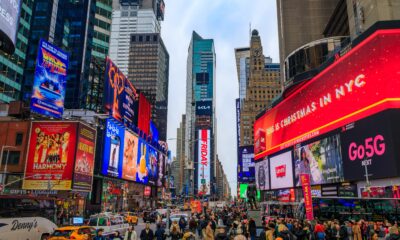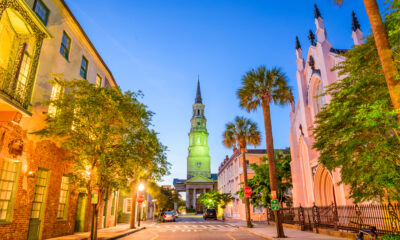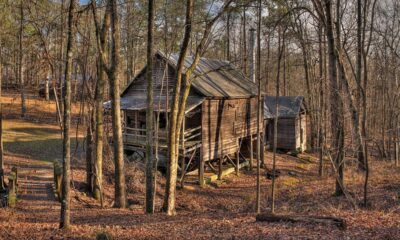Connecticut
One of Wall Street’s first stock market victims built this doomed palace in Connecticut
Published
20 hours agoon

LeGrand Lockwood’s Black Friday Fortune Collapse of 1869
LeGrand Lockwood built his wealth from scratch, rising from clerk to Wall Street titan by age 37. His firm grew huge during the Civil War by selling Union bonds, making him one of America’s first millionaires.
In 1863, he bought 30 acres in his hometown of Norwalk to build a $2 million mansion. Then came September 24, 1869 – Black Friday.
Gold market manipulation by Jay Gould and James Fisk wiped out Lockwood’s fortune in a single day. Soon after, he lost his prized railroad stake to Cornelius Vanderbilt and died at 52.
The grand Lockwood-Mathews Mansion still stands in Connecticut as a perfect monument to America’s first boom-and-bust cycle.

From Clerk to Wall Street Kingpin in Just Five Years
LeGrand Lockwood started as an 18-year-old clerk on Wall Street in 1838. Born in Norwalk, Connecticut in 1820, he quickly caught his bosses’ eye at Shipman, Coming & Co.
His skill with numbers helped him move up to T. Ketchum & Co.
By 23, Lockwood became junior partner at Genin & Lockwood brokerage firm.
His early success came from spotting chances in the booming railroad stock trading business changing America’s economy.

His Own Firm Dominated Railroad Investments
Lockwood joined the New York Stock Exchange in 1851, giving him direct access to the trading floor. In 1857, he took over as senior partner and renamed the firm Lockwood & Co.
The company traded railroad stocks, mostly Lake Shore & Michigan Southern Railroad. Lockwood grew so important that the railroad made him vice president.
His firm became one of Wall Street’s powerhouses, with Lockwood making key choices that shaped America’s growing rail network.

Civil War Bonds Made Him Fabulously Wealthy
The Civil War opened a path to extreme wealth for Lockwood. In 1863, his peers picked him as treasurer of the New York Stock Exchange.
His firm gained fame selling Union bonds throughout Europe, bringing needed foreign money to fund the North’s war effort. These big sales of national war loans earned Lockwood & Co.
the title of “THE LEADING STOCK HOUSE” on Wall Street. Lockwood even backed Company F of the 17th Connecticut Infantry, known as “Lockwood’s Guards.”

A Country Estate Fit For America’s New Royalty
By the late 1850s, Lockwood joined America’s first millionaires through his railroad deals. In 1863, rich with Civil War profits, he bought 30 acres in his boyhood hometown of Norwalk, Connecticut.
He hired architect Detlef Lienau to design a fancy mansion that would show off his wealth and status.
The $2 million “country cottage” called Elm Park wasn’t just a summer home but a statement that he had made it among America’s rich class.

No Expense Spared For His Connecticut Palace
The mansion had 62 rooms with black walnut doors, etched glass panels, and imported marble columns. Lockwood paid Albert Bierstadt $25,000 to paint “The Domes of Yosemite,” the artist’s biggest canvas ever.
His art collection grew to include works by famous painters Frederic Church and William Bradford.
Lockwood built a special eight-sided rotunda with perfect lighting to show the huge Bierstadt masterpiece, turning his home into a private art museum.

Life At The Top Lasted Just One Summer
The Lockwood family moved into their finished mansion during summer 1868, living like the Rockefellers and Vanderbilts. The house featured a grand staircase with lion-head carvings, fancy floors, and a lush plant room.
His library held over 3,000 books surrounded by fancy wallpaper and a glass dome. For a short time, Lockwood lived the Gilded Age dream with servants, parties, and the finest things money could buy.

Railroad Rivals Plotted Behind His Back
During summer 1869, Jay Gould talked to Lockwood about creating a coast-to-coast railroad empire.
As treasurer and big shot at Lake Shore & Michigan Southern Railroad, Lockwood controlled a key part of Gould’s dream for a line connecting New York City to the Pacific coast.
While they talked, rival Cornelius Vanderbilt attacked Lake Shore stock, dropping its price from $120 to $95 per share, putting Lockwood in a tight spot.

One Friday Destroyed Everything He Built
September 24, 1869 became known as Black Friday when Jay Gould and James Fisk’s gold scheme fell apart. President Grant ordered $4 million in Treasury gold sold, crashing gold prices from $162 to $133 in minutes.
The sudden drop caused panic across Wall Street as stock prices fell 20 percent. Dozens of brokers closed forever.
The money earthquake shook Lockwood’s empire to its core, wrecking 25 years of careful work.

Bankruptcy Came Just Days After The Crash
Lockwood & Co. failed on September 29, just five days after Black Friday.
On October 1, the firm went bankrupt despite having $5 million before the crash. Lockwood took out loans on his beloved Elm Park mansion to pay what he owed.
In a final blow, he sold his $10 million stake in Lake Shore & Michigan Southern Railroad to his rival Vanderbilt. The mansion that showed his success now stood for his fight to survive.

A Desperate Race Against Financial Ruin
By December 1869, Lockwood & Co. started limited business again after bankruptcy.
Lockwood, his son Williston, and close friends got back into the NYSE. They worked hard to rebuild their Wall Street standing but struggled to get clients and money.
The loan on his mansion moved from Union Trust Company to Vanderbilt’s control, putting his home at his biggest business rival’s mercy.

His Widow Lost Their Dream Home
LeGrand Lockwood died of pneumonia at age 52 on February 24, 1872 in New York City, never recovering his fortune. Two months later, his widow Ann Louisa auctioned their art collection for $43,190.
Bierstadt’s “Domes of Yosemite,” once the crown jewel of their collection, sold for only $5,100, a fraction of its $25,000 commission price.
In December 1874, unable to make the final $90,000 mortgage payment, Ann Louisa lost the mansion to foreclosure, with ownership passing to Vanderbilt.

Visiting Lockwood-Mathews Mansion, Connecticut
The Lockwood-Mathews Mansion at 295 West Avenue in Norwalk reopened June 4, 2025 after an $18 million restoration. You can take 45 or 90-minute guided tours Wednesday-Sunday from 12-4 PM for $10-35.
The mansion shows how railroad magnate LeGrand Lockwood built his fortune before losing everything during the 1869 Black Friday gold panic.
Check out the skylight rotunda and Herter Brothers furnishings, plus the Bulls of Wall Street exhibit with rare NYSE artifacts through 2025.
This article was created with AI assistance and human editing.
Read more from this brand:
John Ghost is a professional writer and SEO director. He graduated from Arizona State University with a BA in English (Writing, Rhetorics, and Literacies). As he prepares for graduate school to become an English professor, he writes weird fiction, plays his guitars, and enjoys spending time with his wife and daughters. He lives in the Valley of the Sun. Learn more about John on Muck Rack.


15 mountain towns in America where fall feels like a painting

This Connecticut submarine museum boasts the Cold War’s most desperate shopping trip

This Colorado town was literally built to shame its sinful neighbor

The drive that shows Maryland like you’ve never seen before

If You Understand These 14 Slang Terms, You’re Definitely from Arkansas

12 Reasons Why You Should Never Ever Move to Florida

Best national parks for a quiet September visit

In 1907, Congress forced Roosevelt to put God back on U.S. coins. Here’s why.

The radioactive secret White Sands kept from New Mexicans for 30 years

America’s most famous railroad photo erased 12,000 Chinese workers from history
Trending Posts

 Pennsylvania4 days ago
Pennsylvania4 days agoHere Are 12 Things People from Pennsylvania Do That Seem Insane To Everyone Else

 North Carolina5 days ago
North Carolina5 days agoHere Are 12 Things People from North Carolina Do That Seem Insane To Everyone Else

 Maine6 days ago
Maine6 days agoThe ruins of a town that time forgot are resting in this Maine state park

 New York5 days ago
New York5 days agoHere Are 12 Things People from New York Do That Seem Insane To Everyone Else

 South Carolina3 days ago
South Carolina3 days agoHere Are 12 Things People from South Carolina Do That Seem Insane To Everyone Else

 Ohio5 days ago
Ohio5 days agoHere Are 12 Things People from Ohio Do That Seem Insane To Everyone Else

 Georgia6 days ago
Georgia6 days agoThis plantation’s slave quarters tell Georgia’s slowest freedom story

 New Hampshire6 days ago
New Hampshire6 days agoHere Are 12 Things People from New Hampshire Do That Seem Insane To Everyone Else
